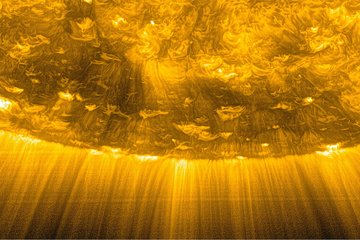All genres
101.
Conference Paper
SUNRISE: High resolution UV/VIS observations of the Sun from the stratosphere. In: Astronomical Telescopes and Instrumentation - The Industrial Revolution in Astronomy, pp. 732 - 741 (Ed. Oschmann, J. M.). SPIE, Bellingham (2004)
102.
Conference Paper
Temporal evolution of chromospheric downflows. In: Multi-Wavelength Investigations of Solar Activity, Proc. IAU Symp. 223, pp. 279 - 280 (Eds. Stepanov, A. V.; Benevolenskaya, E. E.; Kosovichev, A. G.). University Press, Cambridge (2004)
103.
Conference Paper
Characterisation of polarising beamsplitters by ray tracing. In: Polarimetry in Astronomy, pp. 492 - 502 (Ed. Fineschi, S.). SPIE, Washington, USA (2003)
104.
Conference Paper
Magnetic elements near the solar limb: Inversions based on a flux-tube model. In: Proc. International Workshop Solar Polarization 3, pp. 344 - 351 (Eds. Bueno, J. T.; Almeida, J. S.). (2003)
105.
Conference Paper
Imaging polarimetry at the 10−5 level in the optical and near UV part of the solar spectrum. In: Polarimetry in Astronomy, p. 89 (Ed. Fineschi, S.). SPIE, Bellingham, USA (2003)
106.
Conference Paper
Achromatic liquid crystal modulator. In: Polarimetry in Astronomy, p. 45 (Ed. Fineschi, S.). SPIE, Bellingham, US (2003)
107.
Conference Paper
SUNRISE: A Balloon-borne Telescope for High Resolution Solar Observations in the Visible and UV. In: Innovative Telescopes and Instrumentation for Solar Astrophysics, pp. 129 - 139 (Eds. Keil, S. L.; Avakyan, S. V.). SPIE, Washington, US (2003)
108.
Talk
First results from SO/PHI’s on-board data reduction. AGU Fall Meeting, Online (2020)
109.
Talk
Autonomous data reduction for the space-borne spectropolarimeter PHI. Annual meeting of the German Astrophysical Society 2017 - The many Scales of the Universe: Galaxies, their Suns, and their Planets, Göttingen, Germany (2017)
110.
Talk
Autonomous flat field acquisition and correction techniques for the space-borne spectropolarimeter PHI. Rocks and Stars II, Göttingen, Germany (2017)
111.
Poster
Performance analysis of the SO/PHI software framework for on-board data reduction. 28th annual international Astronomical Data Analysis Software & Systems (ADASS) conference, College Park, Maryland, USA (2019)










